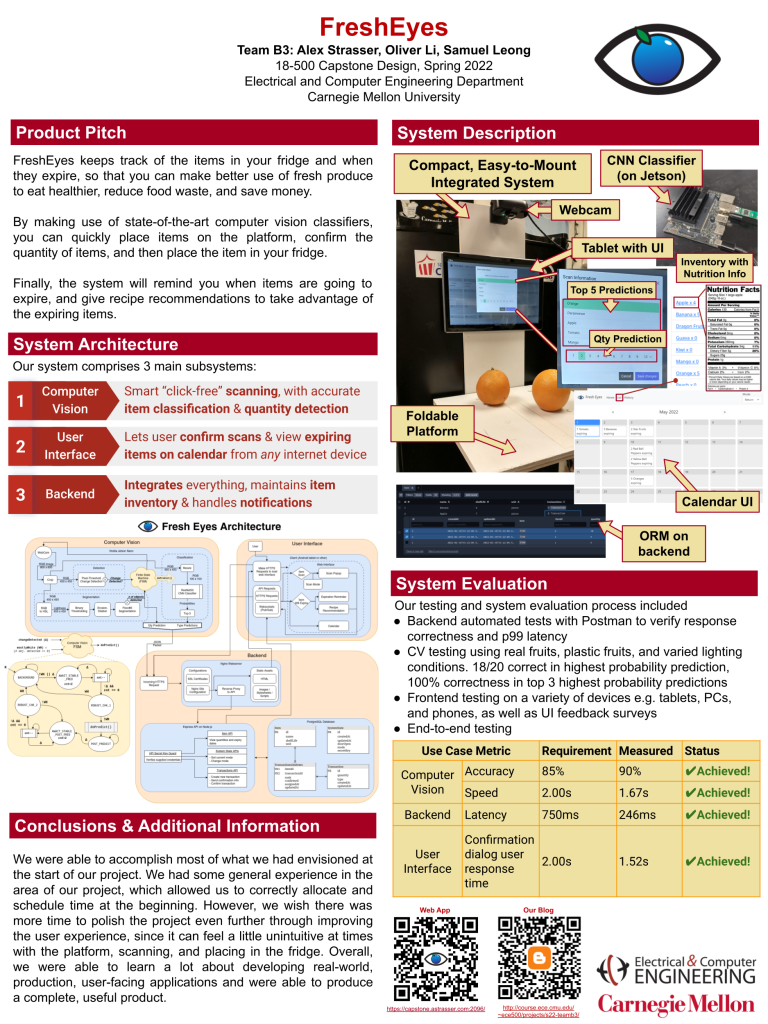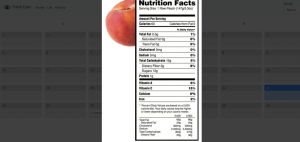FreshEyes – Final Poster (High-Res PDF)
See also page for final product: http://course.ece.cmu.edu/~ece500/projects/s22-teamb3/final-product/
Low-Res Image:

FreshEyes – Final Poster (High-Res PDF)
See also page for final product: http://course.ece.cmu.edu/~ece500/projects/s22-teamb3/final-product/
Low-Res Image:

This week, I finished the final project presentation and watched everyone else’s presentations. For our project, I also worked on attaching the mechanism to the fridge, and training a new network based on the data Samuel collected. The new network still seems to be struggling (as the last one we tried did) on the custom data we collected with a validation accuracy of 30%. If we aren’t able to figure out the bug, we will just fall back on our old network which seems to be working well.
As well as attaching the mechanism to the fridge, I got the system to auto-boot on power up and to be accessible over SSH remotely if we need to access it over the CMU-device network.
Next week, I want to work with Oliver to finish off push notifications for expiring items, as well as recipe recommendations on the front end. This should not be too hard with the existing infrastructure I already have in place. We will also work on finishing up the poster tomorrow and then film the final video. There’s a fair bit of wrap-up work to do but overall we are in great shape!
This week, I worked on finishing some UI fixes and integrating everything together. First, I finished the nutrition information popup:

Then, Samuel and I spray painted the platform for better visibility. The computer vision algorithm improved drastically with the nicer white background.
Next, I set up the Jetson for the computer vision processing. We had a lot of issues with performance, but I discovered that when I disabled all of the GUI processes, the performance improved slightly. We wanted to improve performance using Tensor RT, but I found it very hard to compile (resource limited and arm processor) and no precompiled binaries were available. Fortunately, disabling the GUI was enough to improve performance, but it appears that there is a bug with torchscript that causes the performance to be extremely slow on the first detection. After “warming up” it seems to perform much better, so we will account for this in the code. My hypothesis is that the CPU needs to optimize what goes in the swapfile since it has to use about 1 GB of swap to run the process, which is significantly slower than RAM.
Finally, I tested the performance of the algorithm and we worked out a few bugs on the API and made sure that we are in good shape for the demo. I also collected detection times for our performance evaluation. I then worked on putting all this data into the final presentation.
Last week, we used the saws and equipment from carnival to cut up our wood into usable pieces. This week, we finally got the chance to actually assemble them into a folding platform to assist in our computer vision algorithm. This is necessary to create a nice, light background that is easy to mask out and better detect changes on. For example, when someone walks by, there won’t be significant change to the camera detection since it won’t see the foot, just small changes in lighting. The platform also helps to get more regular sizing of fruit. Users will know to hold it at a consistent height (next to the platform) which makes classification and segmentation much easier.
The folding feature is a small feature so that the fridge takes up less square footage when scanning is not in use.
This week I finished construction of the folding platform for the camera. using the pieces we had cut last week. We found various wood screws in tech spark to finish attaching the foldable hinges. The wood screws were slightly long, so I used hot glue to cover up anything dangerous that could catch.
We also purchased white spray paint for the platform to even further decrease any barriers of detection, but when Samuel ran the computer vision it appeared to work fine with just the light colored wood. I may still paint it next week for aesthetic purposes.
On the front end side, I have begun work on a nutrition information system in place of the recipe recommendation system. The recipe recommendation system was proving very difficult to integrate and test, since these timers are for very long periods of time and required extra frontend and backend integration. Instead, when clicking on items in the interface, it will display nutritional information about the item. For an apple, this will pop up: 
I’m still in the process of integration and will work to finish this up next week. Overall, we’re in very good shape. I just need to get the front end up and running on the tablet next week.
This past week, I worked on integrating scans with the API. We got websockets and a few extra We were able to complete the full pipeline of scan -> API -> popup on the frontend.
I also worked on getting the new neural network trained.
We are back on schedule and ready for the demo!
This week, we did an ethics study on our product and learned about how to make more ethical products.
I also worked on integrating the front end with the back end API. I’m a little behind schedule with this, but this was because I didn’t have the API earlier so I just need to work through this quickly. Unfortunately the API is still incomplete, so I will just have to work through what I can now. This week, we got the first endpoint up to tell us when food is going to expire and adds it to the calendar.
This week, I stalled working on the front end while waiting for the back end to finish and get deployed. In the meantime, I was able to start working a little bit on recipe recommendation, for which I think I will just compile a few links to different recipes based on the final fruits we end up choosing. I also worked on the ethics assignment.
I also spent time training on the old neural network, until we realized that the dataset we were using was not well-suited to our needs.
Lastly, I spent some time dealing with server instability issues, and believe I narrowed down a long term problem I had to SSD failure. I ordered a new SSD off of Amazon which should arrive next week so we can get the front end back up and continue training the neural network.
Although I fell behind on a lot of the tasks I needed to do for front-end, I feel like the end goal is still within reach and I am overcoming necessary hurdles to get there.
This week, I helped with the design review presentation and began work on the design review report. I also assisted Samuel in the training and fixing of the neural network for classification.
I was not able to start the API integration, as the endpoints aren’t ready yet, so I fell slightly behind schedule. However, the API is being built in a much more sustainable way, so making these early sacrifices will save us lots of debugging headaches down the line.
Next week, I will hopefully begin work on integrating the code with the API endpoints, as soon as those are ready.
I worked on a significant portion of the front end, and was able to get a live demo hosted at https://capstone.astrasser.com:2096/
This week I finished the typescript for the site design. I used typescript since in the past it has caught lots of bugs without needing to run and debug for me. Although it took a while to set up, it will pay off in the long run.
Additionally, setting up the domain forwarding was difficult for the demo, but will also speed up development a lot, as it allows me to quickly test on the tablet.
Next week, I will work on integrating the code with the API endpoints. I’m slightly ahead of schedule, but need to work hard since the rest of the semester will get busier.
This week, I mainly worked on the presentation (I was the presenter), and the UI / Front end.
For the presentation: I worked on creating a lot of the content, such as the use case requirements and the solution approach. I practiced presenting and presented our presentation to the class. The presentation went very well and we are set to begin working on our project.
I started the UI off by designing our logo (shown as our website favicon). I set up basic bootstrap for the website.
Next week, I will create the basic calendar interface and the popup for correcting CV detections. Hopefully, when the API endpoints are created, I can start working on basic requests.